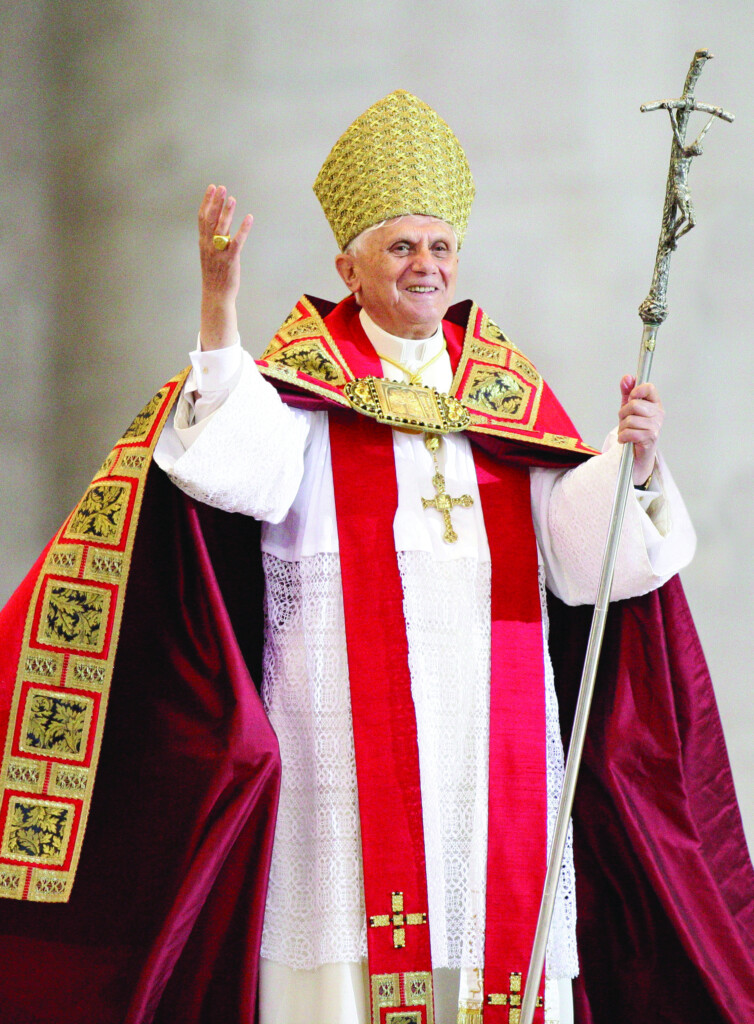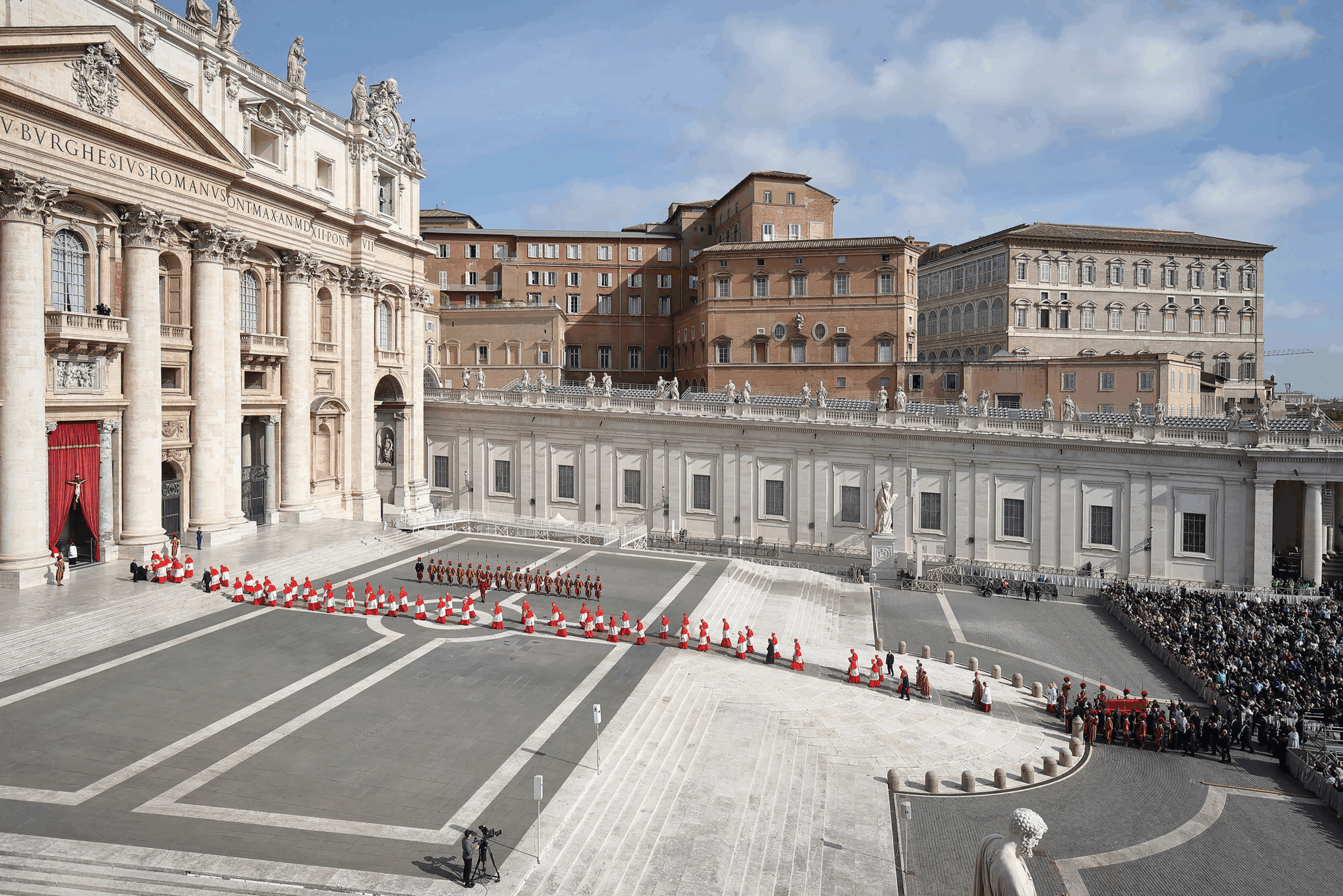Benedict never did object to the new rite of the Mass itself, but rather to the way it was carried out—and to the scandal of prohibiting the older form of the Mass
By Peter A. Kwasniewski

June 3, 2006 — St. Peter’s Square. Pope Benedict XVI during the Vigil of Pentecost with ecclesial movements (Photo Grzegorz Galazka)
Joseph Ratzinger is a theologian from whom I have been learning for decades. Now that he is gone, it seems that fatherly warmth has left the Vatican entirely. Certainly, his theological genius and respect for tradition had already vanished in 2013, with no signs of returning any time soon. At the International Theological Institute in Austria, I enjoyed the privilege of teaching alongside Fr. (then Dr.) John Saward at the time he was putting finishing touches on his translation of The Spirit of the Liturgy.
Although I had already fallen in love with the classical Roman rite by experiencing it in its recited and sung forms, it was Ratzinger who first opened my eyes to why I loved it — the theological and spiritual rationale.
In discussing The Spirit of the Liturgy with fellow appreciators over the past two decades, especially members of the clergy, I learned that it had had the same powerful effect on many of its readers.
At last, we had found a highly literate, sophisticated, rather audacious modern theologian who valued tradition, explained its meaning, rebuked its assailants, and advanced its recovery.
That he was the right-hand man of John Paul II and followed him to the Chair of Peter added to the momentary elation of recovering territory after a series of brutal losses.
As time went on and I delved more deeply both into the Roman rite itself and into the writings of Ratzinger, I learned that there had been a momentous rupture — one that Benedict XVI was eager to downplay for the sake of ecclesial peace, but one that, in his candid moments, he was fully prepared to admit and to decry.
For example, in a letter written in 1976 to the eminent historian of Roman law Prof. Wolfgang Waldstein, Fr. Ratzinger wrote:
“The problem of the new Missal lies in its abandonment of a historical process that was always continual, before and after St. Pius V, and in the creation of a completely new book, although it was compiled of old material, the publication of which was accompanied by a prohibition of all that came before it, which, besides, is unheard of in the history of both law and liturgy. And I can say with certainty, based on my knowledge of the conciliar debates and my repeated reading of the speeches made by the Council Fathers, that this does not correspond to the intentions of the Second Vatican Council. (“Zum motu proprio Summorum Pontificum,” Una Voce Korrespondenz 38/3 [2008], 201–14)
Ten years later, in The Feast of Faith, we find the now Cardinal Ratzinger saying something quite similar, this time to the whole world: “Even the official new books, which are excellent in many ways, occasionally show far too many signs of being drawn up by academics and reinforce the notion that a liturgical book can be ‘made’ like any other book.
“In this connection I would like to make a brief reference to the so-called Tridentine Liturgy.
“In fact there is no such thing as a Tridentine liturgy, and until 1965 the phrase would have meant nothing to anyone. The Council of Trent did not ‘make’ a liturgy. Strictly speaking, there is no such thing, either, as the Missal of Pius V. The Missal which appeared in 1570 by order of Pius V differed only in tiny details from the first printed edition of the Roman Missal of about a hundred years earlier….
“Yet, with all its advantages, the new Missal was published as if it were a book put together by professors, not a phase in a continual growth process. Such a thing has never happened before.
“It is absolutely contrary to the laws of liturgical growth, and it has resulted in the nonsensical notion that Trent and Pius V had ‘produced’ a Missal 400 years ago. The Catholic liturgy was thus reduced to the level of a mere product of modern times.” (pp. 85–87)
We do not find Ratzinger rejecting the new liturgical books, which he used throughout his career from 1969 onwards, but we do find him objecting to the way they were produced, the defects one can find in them, and the scandal of prohibiting the older form of the rite for those who find it spiritually fruitful. He was a consistent advocate of a certain Catholic pluralism, when the progressives showed themselves (ironically?) fixated on a mode of uniformity more characteristic of the Tridentine period they despised in every other respect.
Again, 10 more years later, in 1996, His Eminence, in the interview-book Salt of the Earth, speaks quite openly: “I am of the opinion, to be sure, that the old rite should be granted much more generously to all those who desire it.
“It’s impossible to see what could be dangerous or unacceptable about that.
“A community is calling its very being into question when it suddenly declares that what until now was its holiest and highest possession is strictly forbidden and when it makes the longing for it seem downright indecent.
“Can it be trusted any more about anything else? Won’t it proscribe again tomorrow what it prescribes today?” (pp. 176–77)
In his memoirs Milestones, published in 1997, he says: “Setting it [the new missal] as a new construction over against what had grown historically, forbidding the results of this historical growth, thereby makes the liturgy appear to be no longer a living development but the product of erudite work and juridical authority; this has caused us enormous harm.
“For then the impression had to emerge that liturgy is something ‘made,’ not something given in advance but something lying within our own power of decision.” (p. 148)
One senses a growing urgency and candor on this question.
In God and the World of 2000, he tells us: “For fostering a true consciousness in liturgical matters, it is also important that the proscription against the form of liturgy in valid use up to 1970 [i.e., the usus antiquor] should be lifted.
“Anyone who nowadays advocates the continuing existence of this liturgy or takes part in it is treated like a leper; all tolerance ends here.
“There has never been anything like this in history; in doing this we are despising and proscribing the Church’s whole past.
“How can one trust her at present if things are that way?” (p. 416)
At the Fontgombault conference in 2001, he tells us—as if thinking through in his mind a draft of Summorum Pontificum: “I was from the beginning in favor of the freedom to continue using the old Missal, for a very simple reason: people were already beginning to talk about making a break with the pre-conciliar Church, and of developing various models of Church — a pre-conciliar and obsolete type of Church, and a new and conciliar type of Church…
“I recognize that both Missals are Missals of the Church, and belong to the Church which remains the same as ever… In order to emphasize that there is no essential break, that there is continuity in the Church, which retains its identity, it seems to me indispensable to continue to offer the opportunity to celebrate according to the old Missal, as a sign of the enduring identity of the Church.
“This is for me the most basic reason: what was up until 1969 the Liturgy of the Church, for all of us the most holy thing there was, cannot become after 1969 — with incredibly positivistic decision — the most unacceptable thing.” (pp. 148–49)
Having been elected Pope in 2005, it did not take Benedict XVI a very long time to issue Summorum Pontificum, in the teeth of fiercest resistance.
There is no need to speak at length about a document so important, well-known, and influential, but I should like to quote the key theological principle that enshrines decades of Ratzinger’s consistent thought and pastoral practice: “What earlier generations held as sacred, remains sacred and great for us too, and it cannot be all of a sudden entirely forbidden or even considered harmful. It behooves all of us to preserve the riches which have developed in the Church’s faith and prayer, and to give them their proper place.” (Letter to Bishops Con Grande Fiducia, accompanying Summorum Pontificum)
Finally, almost a decade later, in 2016 — after his abdication — the Pope Emeritus told us again about his motivations for releasing Summorum Pontificum: “I have always said, and even still say, that it was important that something which was previously the most sacred thing in the Church to people should not suddenly be completely forbidden.
“A society that considers now to be forbidden what it once perceived as the central core — that cannot be.
“The inner identity it has with the other must remain visible.
“So for me it was not about tactical matters and God knows what, but about the inward reconciliation of the Church with itself.” (pp. 201–2)
When his German biographer, Peter Seewald, confronts him with the objection, “The reauthorization of the Tridentine Mass is often interpreted primarily as a concession to the Society of Saint Pius X,” the Pope Emeritus replies, with surprising intensity: “This is just absolutely false!
“It was important for me that the Church is one with herself inwardly, with her own past; that what was previously holy to her is not somehow wrong now.”
Anyone reading such lines can readily perceive the extent to which the successor of Benedict XVI dissents from his teaching — and seems to misunderstand, if not misrepresent, his motivations.
It is no mere shift in disciplinary policy that we are looking at here, but a tectonic shift in theological principles. Unfortunately, such a shift is tantamount to a kind of “declaration of war” on tradition.
We pray, along with Pope Benedict, I am sure, that the peace of Christ will soon be restored to His Church as God intends.
 Peter Kwasniewski is an alumnus of Thomas Aquinas College in California, a founding professor of Wyoming Catholic College, and now a freelance writer, editor, publisher, and composer. His many books include the 2021 title From Benedict’s Peace to Francis’s War.
Peter Kwasniewski is an alumnus of Thomas Aquinas College in California, a founding professor of Wyoming Catholic College, and now a freelance writer, editor, publisher, and composer. His many books include the 2021 title From Benedict’s Peace to Francis’s War.






Facebook Comments